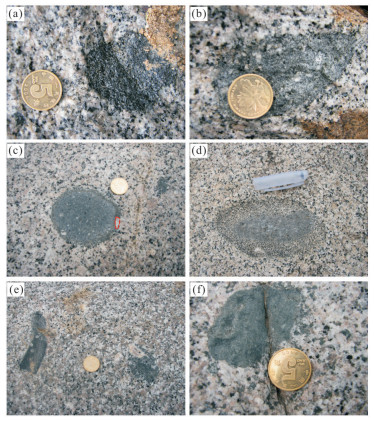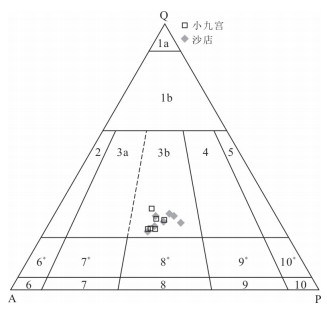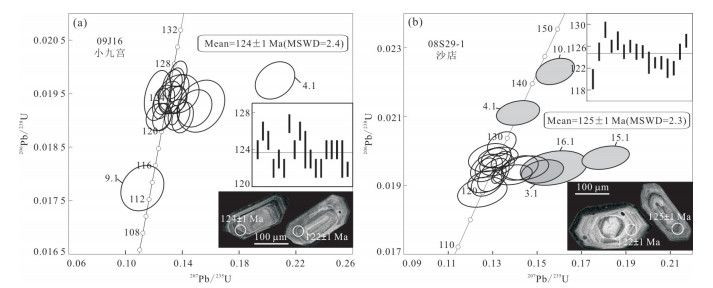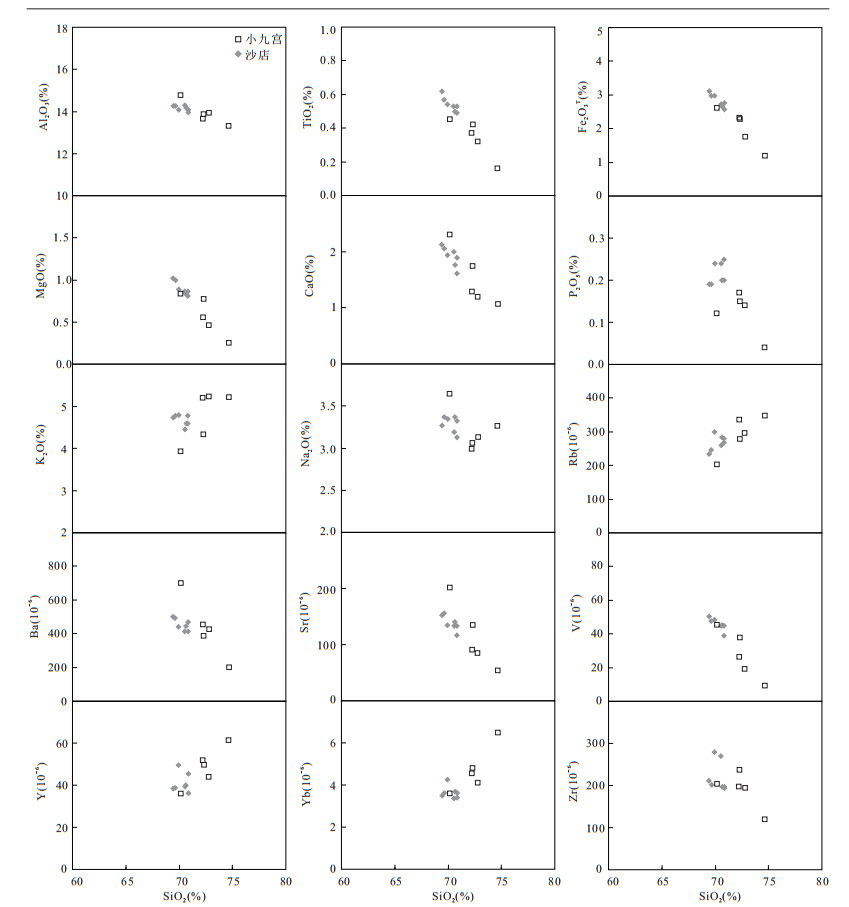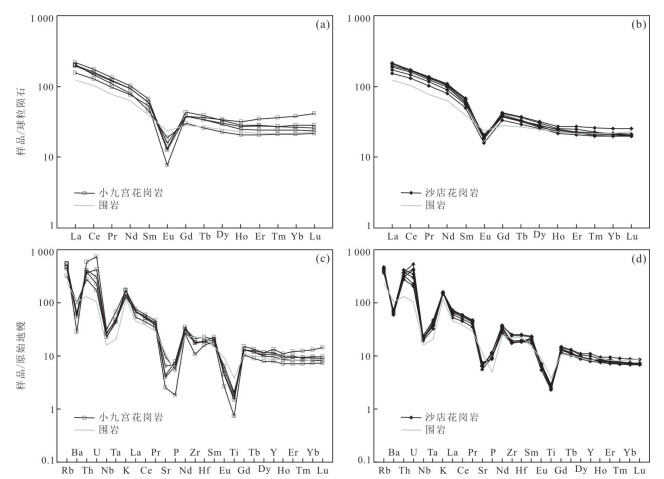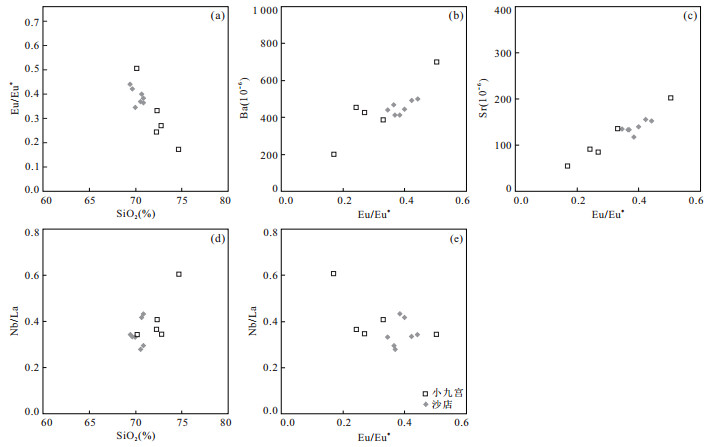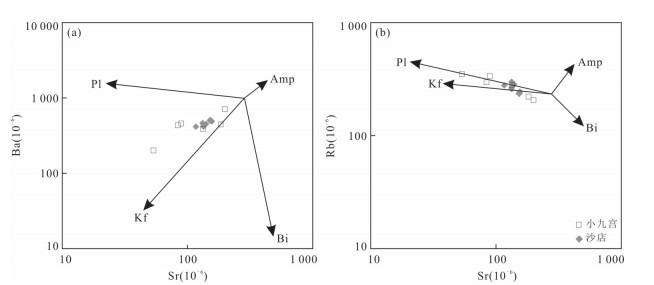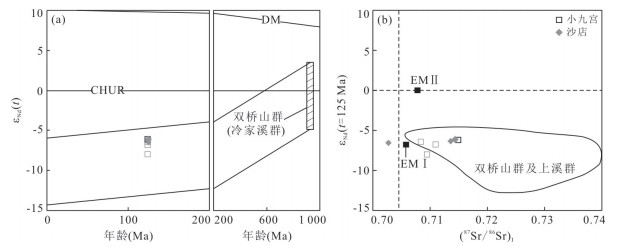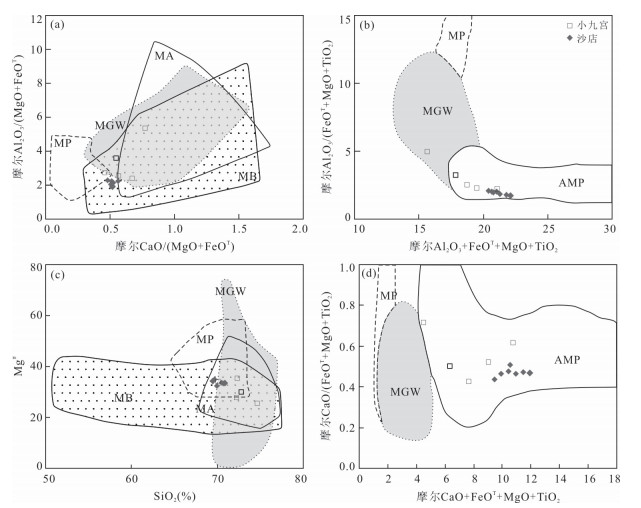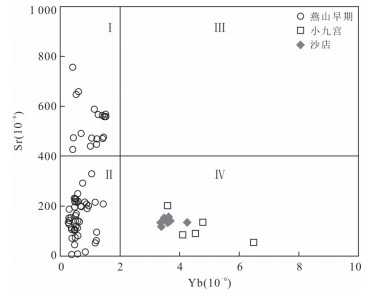Petrogenesis and Tectonic Implications of the Cretaceous Granites from Xiaojiugong-Shadian, Northwest Jiangxi Province
-
摘要: 赣西北-湘东北地区出露较多晚中生代花岗岩,并与中、下扬子地区晚中生代花岗岩组成一条NEE向岩浆岩带.通过对赣西北小九宫和沙店花岗岩进行系统的岩石学、年代学、元素地球化学、全岩Sr-Nd同位素研究,探讨其岩石成因及其构造意义.小九宫和沙店花岗岩的岩石类型主要为中粗粒斑状黑云二长花岗岩,LA-ICP-MS锆石U-Pb定年结果表明,其形成年龄分别为124±1 Ma和125±1 Ma,均为燕山晚期花岗岩.小九宫和沙店花岗岩均具有高钾、钙碱性、贫铁镁的含量特征,主要为弱过铝质花岗岩.两岩体具有相似的稀土元素分布型式和微量元素特征,表现为轻稀土富集的右倾型式,具有明显的Eu负异常(Eu/Eu*=0.17~0.50),富集K、Rb、Th、U等大离子亲石元素,亏损Ba、Sr、P和高场强元素Nb、Ta、Ti等.主量、微量元素地球化学特征显示,两岩体为高钾钙碱性Ⅰ型花岗岩.小九宫和沙店花岗岩的εNd(t)值分别为-8.06~-6.20、-6.51~-6.08,两阶段模式年龄(TDM2)分别为1.42~1.57 Ga、1.42~1.45 Ga.Sr-Nd同位素组成和地球化学特征表明,两岩体主要来源于下地壳源区,其源岩可能为中元古代中性-基性火成岩.小九宫和沙店花岗岩体通过岩墙扩张作用方式被动侵位,结合区域构造背景,认为两岩体形成于伸展构造环境.地幔物质上涌可能为下地壳火成岩部分熔融提供持续的热源,岩浆在上升过程中经历明显的分离结晶作用.岩体中含有少量微粒包体及围岩捕虏体,反映岩浆在上升过程中可能受到较弱的混染作用.区域对比表明,从燕山早期到燕山晚期,赣西北-湘东北地区花岗质岩浆源区存在压力变小的趋势,可能反映了地壳的明显减薄.Abstract: Many Late Mesozoic granites occur in northwest Jiangxi Province and northeast Hunan Province, which constitute a NEE-trending magmatic belt together with the Late Mesozoic granites in the Middle and Lower Yangtze regions. In this paper, it presents the petrogenesis and tectonic implications, based on the systematic petrographical, zircon U-Pb geochronological, geochemical and isotopic analyses of two representative samples from the Xiaojiugong and Shadian granites. The Xiaojiugong and Shadian intrusions principally consist of medium to coarse-grained porphyritic biotite monzogranite. LA-ICP-MS zircon U-Pb dating yields magma crystallization ages of 124±1 Ma for the Xiaojiugong intrusion and 125±1 Ma for the Shadian intrusion. The two intrusions emplaced in the period of Late Yanshanian. The Xiaojiugong and Shadian granites are all characterized by high-K, calc-alkaline and low contents of Fe2O3T and MgO, indicating they are mainly weakly peraluminous granites. They show similar distribution patterns of REE and trace elements, i.e. enrichment in LREE and large-ion lithophile elements of K, Rb, Th and U, depletion in Ba, Sr, P and high field strength elements of Nb, Ta and Ti, and pronounced negative Eu anomalies (Eu/Eu*=0.17-0.50). Major and trace elements show that the Xiaojiugong and Shadian granites are high-K calc-alkaline Ⅰ-type granites. The Xiaojiugong granites have εNd(t) values of -8.06 to -6.20 and two-stage model ages (TDM2) of 1.42-1.57 Ga. The Shadian granites have εNd(t) values of -6.51 to -6.08 and the corresponding TDM2 of 1.42-1.45 Ga. The Sr-Nd isotopic composition and geochemical characteristics of the Xiaojiugong and Shadian granites suggest the main origin of lower crust. Their source might be the Mesoproterozoic neutral-basic igneous rocks. The Xiaojiugong and Shadian granites passively emplaced through expansion of the dikes. Combined with the regional tectonic background, the granites formed in extensional environment, and upwelling mantle probably provided a continuous heat source for the partial melting of lower crustal igneous rocks. The magma experienced a significant process of fractional crystallization during upwelling. A handful of microgranular enclaves and surrounding rock xenoliths in the granites reflect that the granitic magma might have been weekly contaminated when rising. Regional comparison shows that, from Early Yanshanian to Late Yanshanian, the pressure of the granitic magma source decreased significantly in the northwest Jiangxi and northeast Hunan. This might indicate that the crust had undergone significant thinning in the period of Late Mesozoic.
-
Key words:
- zircon U-Pb geochronology /
- geochemistry /
- Sr-Nd isotope /
- Ⅰ-type granite /
- petrogenesis /
- tectonic implication /
- petrology
-
图 4 小九宫和沙店花岗岩的Q A P图解
Q.石英;A.碱性长石;P.斜长石;1a.硅英岩;1b.富石英花岗岩;2.碱性长石花岗岩;3a.正长花岗岩;3b.二长花岗岩;4.花岗闪长岩;5.英云闪长岩;6*.石英碱性长石正长岩;7*.石英正长岩;8*.石英二长岩;9*.石英二长闪长岩/石英二长辉长岩;10*.石英闪长岩/石英辉长岩/石英斜长岩;6.碱性长石正长岩;7.正长岩;8.二长岩;9.二长闪长岩/二长辉长岩;10.闪长岩/辉长岩/斜长岩.据Streckeisen (1974)
Fig. 4. Q A P diagram for the Xiaojiugong and Shadian granites
图 6 小九宫和沙店花岗岩的K2O-SiO2(a)和A/NK-A/CNK图解(b)
图a据Peccerillo and Taylor(1976)
Fig. 6. Diagrams of SiO2 vs. K2O(a) and A/NK vs. A/CNK (b) for the Xiaojiugong and Shadian granites
图 8 小九宫、沙店花岗岩及围岩的球粒陨石标准化稀土元素分布型式(a, b)和原始地幔标准化微量元素蛛网图(c, d)
球粒陨石标准化值据Sun and McDonough(1989);原始地幔标准化值据McDonough and Sun(1995)
Fig. 8. Chondrite normalized REE patterns (a, b) and primitive mantle normalized trace element spidergrams (c, d) for the Xiaojiugong and Shadian granites and surrounding rocks
图 9 小九宫和沙店花岗岩的岩石类型判别图解
FG.分异的长英质花岗岩;OGT.未分异的I-,S-和M-型花岗岩. a.Rb-Y和b.Rb-Th图解据Chappell(1999);c.104 Ga/Al-Nb和d.(Zr+Nb+Ce+Y)-FeOT/MgO图解据Whalen et al.(1987)
Fig. 9. Diagrams of rock type discrimination for the Xiaojiugong and Shadian granites
图 11 小九宫和沙店花岗岩的Ba-Sr(a)和Rb-Sr(b)图解
箭头方向分别表示斜长石(Pl)、钾长石(Kf)、角闪石(Amp)和黑云母(Bi)分异作用对残留熔体成分的影响.Ba、Sr和Rb的配分系数引自Arth and Reston(1976)
Fig. 11. Diagrams of (a) Ba vs. Sr and (b) Rb vs. Sr for the Xiaojiugong and Shadian granites
图 12 小九宫和沙店花岗岩的全岩εNd(t)值-年龄(a)和εNd(t)-(87Sr/86Sr)i(b)图解
图a中双桥山群(冷家溪群)的数据来自本文与Chen and Jahn(1998), 张海祥等(2000);图b中双桥山群及上溪群的Sr-Nd同位素数据来自本文与李献华和桂训唐(1991), 邢凤鸣等(1991)
Fig. 12. Diagrams of whole rock εNd(t) vs. ages (a) and εNd(t) vs.(87Sr/86Sr)i (b) for the Xiaojiugong and Shadian granites
图 13 小九宫和沙店花岗岩的化学成分图解
图中所画区域表示实验研究中不同地壳物质组成通过脱水熔融获得的部分熔融体成分.MB.变质玄武岩(圆点充填区域,实线);MA.变质安山岩(实线,无充填);MGW.变质杂砂岩(灰色充填区域,点线);MP.变泥质岩(虚线,无充填);AMP.角闪岩(实线,加粗);引自Altherr and Siebel(2002), Kaygusuz et al.(2008)
Fig. 13. Chemical variation diagrams for the Xiaojiugong and Shadian granites
图 14 赣西北-湘东北地区燕山期花岗岩的Sr-Yb图解
Ⅰ.高Sr低Yb型;Ⅱ.低Sr低Yb型;Ⅲ.高Sr高Yb型;Ⅳ.低Sr高Yb型;据张旗等(2006).燕山早期的花岗岩数据来自彭头平等(2004), 李鹏春(2006), 许德如等(2009, 2017), Wang et al.(2014)小九宫和沙店花岗岩的主要岩石类型为黑云二长花岗岩,属于高钾钙碱性系列的准铝质-弱过铝质Ⅰ型花岗岩.综合区域上构造和岩浆岩的研究成果,以及小九宫和沙店花岗岩的形成时代(ca.125 Ma)和岩石特征,笔者认为两岩体可能是在与古太平洋板块俯冲有关的岩石圈伸展背景下形成的.
Fig. 14. Diagram of Sr vs. Yb for the Yanshanian granites in northwest Jiangxi and northeast Hunan
表 1 小九宫、沙店花岗岩及围岩的主量(%)、稀土(10-6)和微量元素(10-6)分析结果
Table 1. Major (%), rare earth (10-6) and trace element (10-6) data for the Xiaojiugong and Shadian granites and surrounding rocks
样品号 沙店花岗岩体 小九宫花岗岩体 围岩 08S28-1 08S29-1 08S30-1 08S32-1 09S01 09S04 09S05 09J13 09J14 09J15 09J16 09J18-2 08J33-4 SiO2 69.43 70.65 70.84 69.64 70.54 70.84 69.95 72.81 72.26 72.33 70.17 74.68 66.33 TiO2 0.62 0.50 0.49 0.57 0.53 0.53 0.54 0.32 0.37 0.42 0.45 0.16 0.75 Al2O3 14.27 14.16 14.09 14.25 14.31 13.96 14.08 13.91 13.65 13.86 14.76 13.29 15.89 Fe2O3T 3.11 2.65 2.57 2.98 2.72 2.76 2.97 1.75 2.31 2.27 2.60 1.18 4.87 MnO 0.06 0.06 0.06 0.06 0.06 0.06 0.07 0.04 0.05 0.07 0.07 0.05 0.09 MgO 1.02 0.83 0.81 1.00 0.86 0.86 0.89 0.46 0.55 0.77 0.83 0.25 1.55 CaO 2.13 1.76 1.61 2.06 2.00 1.89 1.94 1.19 1.28 1.74 2.30 1.06 1.62 Na2O 3.27 3.37 3.32 3.37 3.19 3.13 3.35 3.13 2.99 3.06 3.64 3.26 3.16 K2O 4.73 4.59 4.77 4.77 4.45 4.59 4.79 5.23 5.19 4.32 3.92 5.21 3.32 P2O5 0.19 0.20 0.20 0.19 0.24 0.25 0.24 0.14 0.17 0.15 0.12 0.04 0.10 H2O+ 0.55 0.68 0.69 0.63 0.55 0.60 0.66 0.60 0.67 0.55 0.67 0.46 1.56 CO2 0.15 0.15 0.15 0.07 0.12 0.12 0.10 0.12 0.12 0.10 0.08 0.15 0.11 Total 99.53 99.60 99.60 99.59 99.57 99.59 99.58 99.70 99.61 99.64 99.61 99.79 99.35 A/CNK 0.99 1.03 1.04 0.99 1.04 1.03 0.99 1.07 1.06 1.08 1.02 1.03 1.35 A/NK 1.36 1.35 1.33 1.33 1.42 1.38 1.32 1.29 1.30 1.43 1.44 1.21 1.81 K2O+Na2O 8.00 7.96 8.09 8.14 7.64 7.72 8.14 8.36 8.18 7.38 7.56 8.47 6.48 K2O/Na2O 1.45 1.36 1.44 1.42 1.39 1.47 1.43 1.67 1.74 1.41 1.08 1.60 1.05 Mg# 34 33 34 35 34 33 32 30 28 35 34 25 34 Be 3.85 3.80 4.28 3.63 4.83 4.55 4.78 2.66 2.83 5.22 4.55 5.11 2.27 Sc 8.55 8.17 7.28 8.28 8.63 8.87 9.97 6.24 7.74 8.72 8.09 6.90 15.55 V 50.5 45.2 39.1 47.5 44.9 45.0 48.5 19.0 26.3 37.5 45.3 9.2 89.2 Cr 13.2 11.9 10.1 36.5 11.9 10.9 11.2 4.4 9.8 10.8 12.0 3.4 55.7 Co 7.23 6.55 5.75 7.30 6.24 6.05 6.57 2.94 3.96 5.22 5.89 1.39 12.88 Ni 8.24 7.15 6.08 21.80 6.88 7.05 7.58 3.22 5.24 7.46 7.21 2.15 22.93 Cu 62.90 7.54 6.83 4.64 6.80 34.70 23.40 1.40 11.40 7.40 17.00 13.60 7.30 Zn 63.8 70.7 63.0 62.1 58.3 52.3 62.5 39.5 119.8 60.9 60.0 29.9 86.1 Ga 18.9 21.9 19.6 19.0 19.7 19.7 20.4 19.6 20.2 18.7 18.3 17.8 20.0 Rb 234 285 281 247 259 269 300 295 335 278 203 348 144 Sr 152.0 140.0 117.0 156.0 133.0 133.0 134.0 84.2 90.1 135.0 201.0 53.6 225.0 Y 38.3 39.9 36.0 38.8 39.4 45.4 49.6 43.9 51.6 49.5 36.0 61.3 35.4 Zr 212 196 194 201 270 197 280 193 196 236 203 119 228 Nb 15.0 16.9 15.4 15.3 13.6 14.4 16.7 16.3 19.0 18.7 16.3 22.5 10.3 Cs 12.5 20.5 19.4 11.8 12.5 18.2 21.7 9.0 19.6 13.5 19.4 16.3 15.2 Ba 501 446 411 493 414 467 441 424 451 384 698 199 675 La 43.9 40.5 35.7 45.9 48.8 48.9 50.3 47.3 52.0 45.8 47.7 37.2 29.3 Ce 97.3 89.0 79.9 102 103.7 102.3 105.2 96.8 106.5 93.9 89.5 78.1 62.8 Pr 11.9 11.0 9.72 12.5 12.8 12.4 12.9 11.6 12.6 11.3 10.3 9.3 7.4 Nd 45.3 41.6 37.0 47.4 50.4 48.3 49.9 43.2 47.7 43.2 37.1 35.2 29.3 Sm 8.94 8.55 7.62 9.18 10.00 9.81 10.30 8.99 10.20 9.08 7.00 8.14 5.98 Eu 1.18 1.06 0.91 1.16 1.09 1.09 1.07 0.74 0.76 0.91 1.08 0.44 1.38 Gd 7.53 7.64 6.86 7.69 8.15 8.55 8.73 7.70 8.98 7.76 6.18 7.74 5.81 Tb 1.17 1.22 1.09 1.20 1.23 1.36 1.40 1.26 1.46 1.27 0.97 1.35 0.99 Dy 6.73 7.13 6.38 7.01 6.89 7.71 8.02 7.30 8.41 7.69 5.77 8.52 6.21 Ho 1.31 1.35 1.22 1.39 1.27 1.42 1.54 1.41 1.61 1.52 1.16 1.77 1.31 Er 3.60 3.66 3.44 3.74 3.63 4.07 4.49 4.00 4.71 4.55 3.44 5.77 3.58 Tm 0.54 0.55 0.51 0.57 0.52 0.57 0.65 0.62 0.69 0.69 0.53 0.92 0.55 Yb 3.48 3.69 3.39 3.63 3.36 3.60 4.26 4.11 4.53 4.78 3.60 6.48 3.72 Lu 0.50 0.51 0.50 0.53 0.50 0.51 0.64 0.60 0.66 0.71 0.54 1.06 0.57 Hf 6.06 5.79 5.72 5.73 7.46 5.53 7.69 5.79 5.89 7.00 5.75 4.97 6.35 Ta 1.49 1.84 1.69 1.52 1.32 1.63 1.93 1.73 1.96 1.92 1.82 2.76 0.76 Pb 25.3 28.8 25.4 26.4 74.4 271.0 53.5 27.2 394.9 55.8 19.8 308.0 15.8 Th 28.0 26.1 23.7 31.4 34.9 30.4 31.4 32.5 35.3 31.0 23.2 50.5 10.2 U 4.73 8.71 4.31 6.33 7.22 9.00 11.12 4.79 6.48 8.90 3.63 15.57 2.08 (La/Yb)N 9.04 7.86 7.56 9.06 10.41 9.73 8.47 8.25 8.23 6.88 9.52 4.12 5.65 Eu/Eu* 0.44 0.40 0.38 0.42 0.37 0.36 0.34 0.27 0.24 0.33 0.50 0.17 0.72 TZr(℃) 800 800 800 795 831 801 826 806 806 824 801 762 / 注:Fe2O3T为全铁;A/CNK=摩尔Al2O3/(CaO+Na2O+K2O);A/NK=摩尔Al2O3/(Na2O+K2O);Mg#=100×Mg2+/(Mg2++T Fe2+);Eu/Eu*=EuN/(SmN×GdN)1/2,下标N表示球粒陨石标准化后的数据,球粒陨石标准化数值引自Sun and McDonough(1989);TZr=12 900/[2.95+0.85M+ln(496 000/Zrmelt)]( Miller et al., 2003 ),Zrmelt为熔体中Zr含量,M=(Na+K+2×Ca)/(Al×Si)(Watson and Harrison, 1983).表 2 小九宫、沙店花岗岩及围岩的Sr-Nd同位素组成
Table 2. Whole-rock Sr and Nd isotopic compositions for the Xiaojiugong and Shadian granites and surrounding rocks
样品号 Rb
(10-6)Sr
(10-6)87Rb/86Sr 87Sr/86Sr (87Sr/86Sr)i Sm
(10-6)Nd
(10-6)Sm/Nd 147Sm/144Nd 143Nd/144Nd εNd(t) TDM1
(Ga)TDM2
(Ga)小九宫花岗岩体,t=124 Ma 09J13 294.8 84.2 10.149 2 0.732 827 0.714 941 8.99 43.18 0.21 0.125 9 0.512 263 -6.20 1.54 1.42 09J15 278.4 134.8 5.980 9 0.718 965 0.708 424 9.08 43.23 0.21 0.126 9 0.512 249 -6.49 1.58 1.45 09J16 203.3 201.4 2.923 3 0.714 656 0.709 504 7.00 37.12 0.19 0.114 0 0.512 158 -8.06 1.51 1.57 J10 217.5 184.6 3.412 1 0.717 065 0.711 052 8.37 40.56 0.21 0.124 8 0.512 230 -6.82 1.57 1.47 沙店花岗岩体,t=125 Ma 08S29-1 284.5 140.0 5.889 6 0.724 808 0.714 345 8.55 41.60 0.21 0.124 3 0.512 267 -6.08 1.50 1.42 08S32-1 247.0 156.2 4.581 0 0.721 756 0.713 617 9.18 47.45 0.19 0.117 0 0.512 249 -6.32 1.42 1.43 09S05 300.0 134.3 6.466 8 0.714 224 0.702 735 10.33 49.92 0.21 0.125 2 0.512 246 -6.51 1.55 1.45 围岩,t=900 Ma 08J33-4 143.6 225.2 1.845 6 0.708 643 0.684 905 5.98 29.28 0.20 0.1234 0.512 299 1.83 1.43 1.41 注:(1) (87Sr/86Sr)i=(87Sr/86Sr)S+(87Rb/86Sr)S×(eλt-1), λ=1.42×10-11 a-1.(2) εNd(t)=[(143Nd/144Nd)S/(143Nd/144Nd)CHUR(t)-1]×104,(143Nd/144Nd)CHUR(t)=0.512 638-0.196 7×(eλt-1).(3)TDM1=1/λ×ln{1+[((143Nd/144Nd)S-(143Nd/144Nd)DM)/((147Sm/144Nd)S-(147Sm/144Nd)DM)]}; TDM2=1/λ×ln{1+[(143Nd/144Nd)S-(143Nd/144Nd)DM-((147Sm/144Nd)S-(147Sm/144Nd)C)×(eλt-1)]/[(147Sm/144Nd)C-(147Sm/144Nd)DM]}.
公式中的下标S、CHUR、DM、C分别表示样品测量值、球粒陨石值、亏损地幔值、大陆地壳平均值, (143Nd/144Nd)DM=0.513 15, (147Sm/144Nd)DM=0.213 7, (147Sm/144Nd)C=0.118; λSm-Nd=6.54×10-12 a-1; t代表岩浆结晶年龄. -
Altherr, R., Siebel, W., 2002. Ⅰ-Type Plutonism in a Continental Back-Arc Setting:Miocene Granitoids and Monzonites from the Central Aegean Sea, Greece. Contributions to Mineralogy and Petrology, 143(4):397-415. https://doi.org/10.1007/s00410-002-0352-y Arth, J. G., Reston, V., 1976. Behavior of Trace Elements during Magmatic Processes-A Summary of Theoretical Models and Their Applications. Journal of Research of the US Geological Survey, 4(1):41-47. http://cn.bing.com/academic/profile?id=8184351cf3d9c1d9a6afe8ef8f7546cb&encoded=0&v=paper_preview&mkt=zh-cn Chappell, B. W., 1999. Aluminium Saturation in Ⅰ- and S-Type Granites and the Characterization of Fractionated Haplogranites. Lithos, 46(3):535-551. https://doi.org/10.1016/s0024-4937(98)00086-3 Chappell, B. W., White, A. J. R., Wyborn, D., 1987. The Importance of Residual Source Material (Restite) in Granite Petrogenesis. Journal of Petrology, 28(6):1111-1138. https://doi.org/10.1093/petrology/28.6.1111 Chen, J. F., Jahn, B. M., 1998. Crustal Evolution of Southeastern China:Nd and Sr Isotopic Evidence. Tectonophysics, 284(1-2):101-133. https://doi.org/10.1016/s0040-1951(97)00186-8 Ding, L.X., Huang, G.C., Xia, J.L., et al., 2018.Age and Petrogenesis of the Echeng Intrusion in Southeastern Hubei Province:Implications for Iron Mineralization. Earth Science, 43(7):2350-2369(in Chinese with English abstract). http://d.old.wanfangdata.com.cn/Periodical/dqkx201807011 Foley, S. F., Barth, M. G., Jenner, G. A., 2000. Rutile/Melt Partition Coefficients for Trace Elements and an Assessment of the Influence of Rutile on the Trace Element Characteristics of Subduction Zone Magmas. Geochimica et Cosmochimica Acta, 64(5):933-938. https://doi.org/10.1016/s0016-7037(99)00355-5 Gao, S., Zhang, B. R., Xie, Q. L., et al., 1991. Average Chemical Compositions of Post-Archean Sedimentary and Volcanic Rocks from the Qinling Orogenic Belt and its Adjacent North China and Yangtze Cratons. Chemical Geology, 92(4):261-282. https://doi.org/10.1016/0009-2541(91)90074-2 Hutton, D. H. W., 1988. Granite Emplacement Mechanisms and Tectonic Controls:Inferences from Deformation Studies. Earth and Environmental Science Transactions of the Royal Society of Edinburgh, 79(2-3):245-255. https://doi.org/10.1017/s0263593300014255 Kaygusuz, A., Siebel, W., Şen, C., et al., 2008. Petrochemistry and Petrology of Ⅰ-Type Granitoids in an Arc Setting:The Composite Torul Pluton, Eastern Pontides, NE Turkey. International Journal of Earth Sciences, 97(4):739-764. https://doi.org/10.1007/s00531-007-0188-9 Li, J. W., Zhao, X. F., Zhou, M. F., et al., 2009. Late Mesozoic Magmatism from the Daye Region, Eastern China:U-Pb Ages, Petrogenesis, and Geodynamic Implications. Contributions to Mineralogy and Petrology, 157(3):383-409. https://doi.org/10.1007/s00410-008-0341-x Li, P. C., 2006. Magmatism of Phanerozoic Granitoids in Southeastern Hunan Province, China and Its Evolution Regularity (Dissertation). Institute of Geochemistry, Chinese Academy of Sciences, Guangzhou (in Chinese with English abstract). Li, X. H., Chung, S. L., Zhou, H. W., et al., 2004. Jurassic Intraplate Magmatism in Southern Hunan-Eastern Guangxi:40Ar/39Ar Dating, Geochemistry, Sr-Nd Isotopes and Implications for the Tectonic Evolution of SE China. Geological Society, London, Special Publications, 226(1):193-215. https://doi.org/10.1144/gsl.sp.2004.226.01.11 Li, X. H., Gui, X. T., 1991. Source Rocks of the Caledonian-Age Granitoid Rocks in Wanyangshan and Zhuguangshan, Southeast China (Ⅰ)-Evidence from Sr-Nd-Pb-O Isotopic Constraints. Science in China (Ser.B), 21(5):533-540 (in Chinese). Li, X. H., Li, W. X., Wang, X. C., et al., 2010. SIMS U-Pb Zircon Geochronology of Porphyry Cu-Au-(Mo) Deposits in the Yangtze River Metallogenic Belt, Eastern China:Magmatic Response to Early Cretaceous Lithospheric Extension. Lithos, 119(3-4):427-438. https://doi.org/10.1016/j.lithos.2010.07.018 Li, Z. X., Li, X. H., 2007. Formation of the 1 300-km-Wide Intracontinental Orogen and Postorogenic Magmatic Province in Mesozoic South China:A Flat-Slab Subduction Model. Geology, 35(2):179. https://doi.org/10.1130/g23193a.1 Li,Z.X.,Li,X.H.,Zhou, H.W.,et al.,2002. Grenvillian Continental Collision in South China:New SHRIMP U-Pb Zircon Results and Implications for the Configuration of Rodinia. Geology, 30(2):163-166. https://doi.org/10.1130/0091-7613(2002)030 <0163:gccisc>2.0.co;2 Ling, M. X., Wang, F. Y., Ding, X., et al., 2009a. Cretaceous Ridge Subduction along the Lower Yangtze River Belt, Eastern China. Economic Geology, 104(2):303-321. https://doi.org/10.2113/gsecongeo.104.2.303 Ling, W. L., Duan, R. C., Xie, X. J., et al., 2009b. Contrasting Geochemistry of the Cretaceous Volcanic Suites in Shandong Province and Its Implications for the Mesozoic Lower Crust Delamination in the Eastern North China Craton. Lithos, 113(3-4):640-658. https://doi.org/10.1016/j.lithos.2009.07.001 Liu, Y.S., Gao, S., Hu, Z.C., et al., 2010. Continental and Oceanic Crust Recycling-Induced Melt-Peridotite Interactions in the Trans-North China Orogen:U-Pb Dating, Hf Isotopes and Trace Elements in Zircons from Mantle Xenoliths. Journal of Petrology, 51(1-2):537-571. https://doi.org/10.1093/petrology/egp082 Liu, Y. S., Zong, K. Q., Kelemen, P. B., et al., 2008. Geochemistry and Magmatic History of Eclogites and Ultramafic Rocks from the Chinese Continental Scientific Drill Hole:Subduction and Ultrahigh-Pressure Metamorphism of Lower Crustal Cumulates. Chemical Geology, 247(1-2):133-153. https://doi.org/10.1016/j.chemgeo.2007.10.016 Ludwig, K.R., 2003. User's Manual for Isoplot 3.00:A Geochronological Toolkit for Microsoft Excel. Berkeley Geochronology Center Special Publication, California. Maniar, P.D., Piccoli, P.M., 1989. Tectonic Discrimination of Granitoids. Geological Society of America Bulletin, 101(5):635-643. https://doi.org/10.1130/0016-7606(1989)101 <0635:tdog>2.3.co; 2 McDonough, W. F., Sun, S. S., 1995. The Composition of the Earth. Chemical Geology, 120(3-4):223-253. https://doi.org/10.1016/0009-2541(94)00140-4 Miller, C. F., McDowell, S. M., Mapes, R. W., 2003. Hot and Cold Granites? Implications of Zircon Saturation Temperatures and Preservation of Inheritance. Geology, 31(6):529-532. https://doi.org/10.1130/0091-7613(2003)031 <0529:hacgio>2.0.co; 2 Noyes, H. J., Frey, F. A., Wones, D. R., 1983. A Tale of Two Plutons:Geochemical Evidence Bearing on the Origin and Differentiation of the Red Lake and Eagle Peak Plutons, Central Sierra Nevada, California. The Journal of Geology, 91(5):487-509. https://doi.org/10.1086/628801 Peccerillo, A., Taylor, S. R., 1976. Geochemistry of Eocene Calc-Alkaline Volcanic Rocks from the Kastamonu Area, Northern Turkey. Contributions to Mineralogy and Petrology, 58(1):63-81. https://doi.org/10.1007/bf00384745 Peng, T.P., Xi, X.W., Wang, Y.J., et al., 2004.Geochemical Characteristics of the Early Mesozoic Granodiorites and Their Tectonic Implications. Geotectonica et Metallogenia, 28(3):287-296(in Chinese with English abstract). http://cn.bing.com/academic/profile?id=55c7e3b2d6d18e3e03d3c26e920db87a&encoded=0&v=paper_preview&mkt=zh-cn Qiu, J. S., Xiao, E., Hu, J., et al., 2008. Petrogenesis of Highly Fractionated Ⅰ-type Granites in the Coastal Area of Northeastern Fujian Province:Constraints from Zircon U-Pb Geochronology, Geochemistry and Nd-Hf Isotopes. Acta Petrologica Sinica, 24(11):2468-2484 (in Chinese with English abstract). https://researchers.mq.edu.au/en/publications/petrogenesis-of-highly-fractionated-i-type-granites-in-the-coasta Streckeisen, A., 1974. Classification and Nomenclature of Plutonic Rocks Recommendations of the IUGS Subcommission on the Systematics of Igneous Rocks. Geologische Rundschau, 63(2):773-786. https://doi.org/10.1007/bf01820841 Sun, S. S., McDonough, W. F., 1989. Chemical and Isotopic Systematics of Oceanic Basalts:Implications for Mantle Composition and Processes. Geological Society, London, Special Publications, 42(1):313-345. https://doi.org/10.1144/gsl.sp.1989.042.01.19 Vernon, R. H., 1984. Microgranitoid Enclaves in Granites-Globules of Hybrid Magma Quenched in a Plutonic Environment. Nature, 309(5967):438-439. https://doi.org/10.1038/309438a0 Wang, L. X., Ma, C. Q., Zhang, C., et al., 2014. Genesis of Leucogranite by Prolonged Fractional Crystallization:A Case Study of the Mufushan Complex, South China. Lithos, 206-207(1):147-163. https://doi.org/10.1016/j.lithos.2014.07.026 Wang, Q., Wyman, D. A., Xu, J. F., et al., 2006. Petrogenesis of Cretaceous Adakitic and Shoshonitic Igneous Rocks in the Luzong Area, Anhui Province (Eastern China):Implications for Geodynamics and Cu-Au Mineralization. Lithos, 89(3-4):424-446. https://doi.org/10.1016/j.lithos.2005.12.010 Wang, T., Wang, X.X., Zheng, Y.D., et al., 2007.Studies on Structures of Granitic Plutons and Granitic Tectonic Dynamics. Chinese Journal of Geology(Scientia Geologica Sinica), 42(1):91-113(in Chinese with English abstract). http://www.wanfangdata.com.cn/details/detail.do?_type=perio&id=dzkx200701009 Wang, Y., Ma, C. Q., Wang, L. X., et al., 2018. Zircon U-Pb Geochronology, Geochemistry and Sr-Nd-Hf Isotopes of the Neoproterozoic Granites on the Southeastern Margin of the Yangtze Block:Constraint on Crustal Growth. Earth Science, 43(3):635-654 (in Chinese with English abstract). https://www.sciencedirect.com/science/article/pii/S1342937X18300820 Watson, E. B., Harrison, T. M., 1983. Zircon Saturation Revisited:Temperature and Composition Effects in a Variety of Crustal Magma Types. Earth and Planetary Science Letters, 64(2):295-304. https://doi.org/10.1016/0012-821x(83)90211-x Whalen, J. B., Currie, K. L., Chappell, B. W., 1987. A-Type Granites:Geochemical Characteristics, Discrimination and Petrogenesis. Contributions to Mineralogy and Petrology, 95(4):407-419. https://doi.org/10.1007/bf00402202 Wu, F. Y., Ji, W. Q., Sun, D. H., et al., 2012. Zircon U-Pb Geochronology and Hf Isotopic Compositions of the Mesozoic Granites in Southern Anhui Province, China. Lithos, 150(5):6-25. https://doi.org/10.1016/j.lithos.2012.03.020 Wu, F.Y., Liu, X.C., Ji, W.Q., et al., 2017.Highly Fractionated Granites:Recognition and Research.Scientia Sinica(Terrae), 47(7):745-765(in Chinese). http://d.old.wanfangdata.com.cn/Periodical/dizhixb201708010 Xing, F.M., Chen, J.F., Xu, X., et al., 1991. Nd Isotopic Characteristics of Low Grade Metamorphic and Sedimentary Rocks from Southern Anhui Province and Their Significance in Tectonics. Geoscience, 5(3):290-299 (in Chinese with English abstract). doi: 10.1007%2FBF02869687 Xu, D.R., Deng, T., Dong, G.J., et al., 2017.Zircon U-Pb Geochronological and Geochemical Characteristics of the Lianyunshan Two-Mica Monzogranites in Northeastern Hunan Province:Implications for Petrogenesis and Tectonic Setting Associated with Polymetallic Mineralization. Earth Science Frontiers, 24(2):104-122(in Chinese with English abstract). https://www.sciencedirect.com/science/article/pii/S002449370600291X Xu, D. R., Wang, L., Li, P. C., et al., 2009. Petrogenesis of the Lianyunshan Granites in Northeastern Hunan Province, South China, and Its Geodynamic Implications. Acta Petrologica Sinica, 25(5):1056-1078 (in Chinese with English abstract). http://www.wanfangdata.com.cn/details/detail.do?_type=perio&id=ysxb98200905003 Yu, X. Q., Wu, G. G., Zhang, D., et al., 2006. Cretaceous Extension of the Ganhang Tectonic Belt, Southeastern China:Constraints from Geochemistry of Volcanic Rocks. Cretaceous Research, 27(5):663-672. https://doi.org/10.1016/j.cretres.2006.03.008 Zhang, H. X., Sun, D. Z., Zhu, B. Q., et al., 2000. Pb, Nd Isotopic Study of Proterozoic Metamorphic Sediments in North Jiangxi and Its Tectonic Significance. Regional Geology of China, 19(1):66-71 (in Chinese with English abstract). http://www.wanfangdata.com.cn/details/detail.do?_type=perio&id=zgqydz200001011 Zhang, Q., 2012. Could Granitic Magmas Experience Fractionation and Evolution?. Acta Petrologica et Mineralogica, 31(2):252-260 (in Chinese with English abstract). http://d.old.wanfangdata.com.cn/Periodical/yskwxzz201202013 Zhang, Q., Jin, W.J., Li, C.D., et al., 2009.Yanshanian Large-Scale Magmatism and Lithosphere Thinning in Eastern China:Relation to Large Igneous Province. Earth Science Frontiers, 16(2):21-51(in Chinese with English abstract). Zhang, Q., Pan, G. Q., Li, C. D., et al., 2007. Does Fractional Crystallization Occur in Granitic Magma?. Some Crucial Questions on Granite Study (2). Acta Petrologica Sinica, 23(6):1239-1251 (in Chinese with English abstract). http://cn.bing.com/academic/profile?id=32fd98c039353c6341075d52dadee784&encoded=0&v=paper_preview&mkt=zh-cn Zhang, Q., Wang, Y., Li, C.D., et al., 2006.A Granite Classification Based on Pressures. Geological Bulletin of China, 25(11):1274-1278(in Chinese with English abstract). http://cn.bing.com/academic/profile?id=6a02a8b305b36a24fc8198db9c86e0bb&encoded=0&v=paper_preview&mkt=zh-cn Zhou, M. F., Yan, D. P., Kennedy, A. K., et al., 2002. SHRIMP U-Pb Zircon Geochronological and Geochemical Evidence for Neoproterozoic Arc-Magmatism along the Western Margin of the Yangtze Block, South China. Earth and Planetary Science Letters, 196(1-2):51-67. https://doi.org/10.1016/s0012-821x(01)00595-7 Zhou, X. M., Sun, T., Shen, W. Z., et al., 2006. Petrogenesis of Mesozoic Granitoids and Volcanic Rocks in South China:A Response to Tectonic Evolution. Episodes, 29(1):26-33. https://doi.org/10.18814/epiiugs/2006/v29i1/004 丁丽雪, 黄圭成, 夏金龙, 等, 2018.鄂东南地区鄂城岩体的时代、成因及其对成矿作用的指示.地球科学, 43(7):2350-2369. doi: 10.3799/dqkx.2018.569 李鹏春, 2006.湘东北地区显生宙花岗岩岩浆作用及其演化规律(博士学位论文).广州: 中国科学院地球化学研究所. 李献华, 桂训唐, 1991.万洋山-诸广山加里东期花岗岩的物质来源——Ⅰ.Sr-Nd-Pb-O多元同位素体系示踪.中国科学B辑, 21(5):533-540. http://www.cnki.com.cn/Article/CJFDTotal-JBXK199105011.htm 彭头平, 席先武, 王岳军, 等, 2004.湘东北早中生代花岗闪长岩地球化学特征及其构造意义.大地构造与成矿学, 28(3):287-296. http://d.old.wanfangdata.com.cn/Periodical/ddgzyckx200403009 邱检生, 肖娥, 胡建, 等, 2008.福建北东沿海高分异Ⅰ型花岗岩的成因:锆石U-Pb年代学、地球化学和Nd-Hf同位素制约.岩石学报, 24(11):2468-2484. http://d.old.wanfangdata.com.cn/Periodical/ysxb98200811002 王涛, 王晓霞, 郑亚东, 等, 2007.花岗岩构造研究及花岗岩构造动力学刍议.地质科学, 42(1):91-113. http://d.old.wanfangdata.com.cn/Periodical/dzkx200701009 王艳, 马昌前, 王连训, 等, 2018.扬子东南缘新元古代花岗岩的锆石U-Pb年代学、地球化学和Sr-Nd-Hf同位素:对地壳生长的约束.地球科学, 43(3):635-654. doi: 10.3799/dqkx.2018.900 吴福元, 刘小驰, 纪伟强, 等, 2017.高分异花岗岩的识别与研究.中国科学:地球科学, 47(7):745-765. http://www.wanfangdata.com.cn/details/detail.do?_type=perio&id=zgkx-cd201707001 邢凤鸣, 陈江峰, 徐祥, 等, 1991.皖南浅变质岩和沉积岩的钕同位素特点及其大地构造意义.现代地质, 5(3):290-299. 许德如, 邓腾, 董国军, 等, 2017.湘东北连云山二云母二长花岗岩的年代学和地球化学特征:对岩浆成因和成矿地球动力学背景的启示.地学前缘, 24(2):104-122. http://d.old.wanfangdata.com.cn/Periodical/dxqy201702012 许德如, 王力, 李鹏春, 等, 2009.湘东北地区连云山花岗岩的成因及地球动力学暗示.岩石学报, 25(5):1056-1078. http://d.old.wanfangdata.com.cn/Periodical/ysxb98200905003 张海祥, 孙大中, 朱炳泉, 等, 2000.赣北元古代变质沉积岩的铅钕同位素特征.中国区域地质, 19(1):66-71. http://d.old.wanfangdata.com.cn/Periodical/zgqydz200001011 张旗, 2012.花岗质岩浆能够结晶分离和演化吗?岩石矿物学杂志, 31(2):252-260. http://d.old.wanfangdata.com.cn/Periodical/yskwxzz201202013 张旗, 金惟俊, 李承东, 等, 2009.中国东部燕山期大规模岩浆活动与岩石圈减薄:与大火成岩省的关系.地学前缘, 16(2):21-51. http://www.cnki.com.cn/Article/CJFDTotal-DXQY200902003.htm 张旗, 潘国强, 李承东, 等, 2007.花岗岩结晶分离作用问题——关于花岗岩研究的思考之二.岩石学报, 23(6):1239-1251. doi: 10.1016-j.jpdc.2005.04.005/ 张旗, 王焰, 李承东, 等, 2006.花岗岩按照压力的分类.地质通报, 25(11):1274-1278. http://d.old.wanfangdata.com.cn/Periodical/zgqydz200611004 -
 dqkx-45-4-1115-Table1.pdf
dqkx-45-4-1115-Table1.pdf

-










 下载:
下载:

